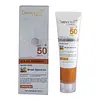What's inside
What's inside
 Key Ingredients
Key Ingredients

 Benefits
Benefits

 Concerns
Concerns

 Ingredients Side-by-side
Ingredients Side-by-side

Water
Skin ConditioningCyclopentasiloxane
EmollientZinc Oxide
Cosmetic ColorantButyloctyl Salicylate
Skin ConditioningDimethicone
EmollientC12-15 Alkyl Benzoate
AntimicrobialGlycerin
HumectantTitanium Dioxide
Cosmetic ColorantCetyl PEG/PPG-10/1 Dimethicone
EmulsifyingPEG-10 Dimethicone
Skin ConditioningDipropylene Glycol
HumectantNiacinamide
SmoothingPolymethyl Methacrylate
Cyclomethicone
EmollientHydrogenated Polydecene
EmollientSilica
AbrasiveHydrogen Dimethicone
Sodium Chloride
MaskingAluminum Hydroxide
EmollientPolyhydroxystearic Acid
EmulsifyingStearic Acid
CleansingSorbitan Olivate
EmulsifyingDisteardimonium Hectorite
StabilisingDimethicone/Vinyl Dimethicone Crosspolymer
Skin ConditioningSorbitan Sesquioleate
EmulsifyingPolyepsilon-Lysine
Skin ConditioningAdenosine
Skin ConditioningPolysilicone-11
Bisabolol
MaskingQuartz
AbrasiveCamellia Japonica Seed Oil
EmollientButylene Glycol
HumectantCentella Asiatica Extract
Cleansing1,2-Hexanediol
Skin ConditioningAsiaticoside
AntioxidantAsiatic Acid
Skin ConditioningMadecassic Acid
Skin ConditioningMadecassoside
AntioxidantWater, Cyclopentasiloxane, Zinc Oxide, Butyloctyl Salicylate, Dimethicone, C12-15 Alkyl Benzoate, Glycerin, Titanium Dioxide, Cetyl PEG/PPG-10/1 Dimethicone, PEG-10 Dimethicone, Dipropylene Glycol, Niacinamide, Polymethyl Methacrylate, Cyclomethicone, Hydrogenated Polydecene, Silica, Hydrogen Dimethicone, Sodium Chloride, Aluminum Hydroxide, Polyhydroxystearic Acid, Stearic Acid, Sorbitan Olivate, Disteardimonium Hectorite, Dimethicone/Vinyl Dimethicone Crosspolymer, Sorbitan Sesquioleate, Polyepsilon-Lysine, Adenosine, Polysilicone-11, Bisabolol, Quartz, Camellia Japonica Seed Oil, Butylene Glycol, Centella Asiatica Extract, 1,2-Hexanediol, Asiaticoside, Asiatic Acid, Madecassic Acid, Madecassoside
Water
Skin ConditioningEthylhexyl Methoxycinnamate
UV AbsorberDimethicone
EmollientEthylhexyl Salicylate
UV AbsorberPropanediol
SolventSilica
AbrasiveBis-Ethylhexyloxyphenol Methoxyphenyl Triazine
Skin ConditioningPolymethylsilsesquioxane
Sodium Acrylate/Sodium Acryloyldimethyl Taurate Copolymer
Emulsion StabilisingSaccharide Isomerate
HumectantHydrolyzed Jojoba Esters
Skin ConditioningPhenoxyethanol
PreservativeIsohexadecane
EmollientChlorphenesin
AntimicrobialPolysorbate 80
EmulsifyingDisodium EDTA
Sorbitan Oleate
EmulsifyingBenzophenone-3
UV AbsorberHamamelis Virginiana Water
AstringentAloe Barbadensis Leaf Juice
Skin ConditioningGlycerin
HumectantCitric Acid
BufferingSodium Citrate
BufferingPolygonum Aviculare Extract
EmollientMelanin
Skin ProtectingPalmitoyl Tripeptide-5
Skin ConditioningPotassium Sorbate
PreservativeSodium Benzoate
MaskingPentylene Glycol
Skin ConditioningBenzoic Acid
MaskingEthylhexylglycerin
Skin ConditioningWater, Ethylhexyl Methoxycinnamate, Dimethicone, Ethylhexyl Salicylate, Propanediol, Silica, Bis-Ethylhexyloxyphenol Methoxyphenyl Triazine, Polymethylsilsesquioxane, Sodium Acrylate/Sodium Acryloyldimethyl Taurate Copolymer, Saccharide Isomerate, Hydrolyzed Jojoba Esters, Phenoxyethanol, Isohexadecane, Chlorphenesin, Polysorbate 80, Disodium EDTA, Sorbitan Oleate, Benzophenone-3, Hamamelis Virginiana Water, Aloe Barbadensis Leaf Juice, Glycerin, Citric Acid, Sodium Citrate, Polygonum Aviculare Extract, Melanin, Palmitoyl Tripeptide-5, Potassium Sorbate, Sodium Benzoate, Pentylene Glycol, Benzoic Acid, Ethylhexylglycerin
 Reviews
Reviews

Ingredients Explained
These ingredients are found in both products.
Ingredients higher up in an ingredient list are typically present in a larger amount.
Dimethicone is a type of synthetic silicone created from natural materials such as quartz.
What it does:
Dimethicone comes in different viscosities:
Depending on the viscosity, dimethicone has different properties.
Ingredients lists don't always show which type is used, so we recommend reaching out to the brand if you have questions about the viscosity.
This ingredient is unlikely to cause irritation because it does not get absorbed into skin. However, people with silicone allergies should be careful about using this ingredient.
Note: Dimethicone may contribute to pilling. This is because it is not oil or water soluble, so pilling may occur when layered with products. When mixed with heavy oils in a formula, the outcome is also quite greasy.
Learn more about DimethiconeGlycerin is already naturally found in your skin. It helps moisturize and protect your skin.
A study from 2016 found glycerin to be more effective as a humectant than AHAs and hyaluronic acid.
As a humectant, it helps the skin stay hydrated by pulling moisture to your skin. The low molecular weight of glycerin allows it to pull moisture into the deeper layers of your skin.
Hydrated skin improves your skin barrier; Your skin barrier helps protect against irritants and bacteria.
Glycerin has also been found to have antimicrobial and antiviral properties. Due to these properties, glycerin is often used in wound and burn treatments.
In cosmetics, glycerin is usually derived from plants such as soybean or palm. However, it can also be sourced from animals, such as tallow or animal fat.
This ingredient is organic, colorless, odorless, and non-toxic.
Glycerin is the name for this ingredient in American English. British English uses Glycerol/Glycerine.
Learn more about GlycerinSilica, also known as silicon dioxide, is a naturally occurring mineral. It is used as a fine, spherical, and porous powder in cosmetics.
Though it has exfoliant properties, the function of silica varies depending on the product.
The unique structure of silica enhances the spreadability and adds smoothness, making it a great texture enhancer.
It is also used as an active carrier, emulsifier, and mattifier due to its ability to absorb excess oil.
In some products, tiny microneedles called spicules are made from silica or hydrolyzed sponge. When you rub them in, they lightly polish away dead skin layers and enhance the penetration of active ingredients.
Learn more about SilicaWater. It's the most common cosmetic ingredient of all. You'll usually see it at the top of ingredient lists, meaning that it makes up the largest part of the product.
So why is it so popular? Water most often acts as a solvent - this means that it helps dissolve other ingredients into the formulation.
You'll also recognize water as that liquid we all need to stay alive. If you see this, drink a glass of water. Stay hydrated!
Learn more about Water